Journal of Southern Medical University ›› 2025, Vol. 45 ›› Issue (6): 1200-1211.doi: 10.12122/j.issn.1673-4254.2025.06.09
Previous Articles Next Articles
Yanxiu MO1( ), Yang SHU2, Yulan MO3, Juntong LIU1, Ouou XU1, Huafei DENG1, Qiben WANG1(
), Yang SHU2, Yulan MO3, Juntong LIU1, Ouou XU1, Huafei DENG1, Qiben WANG1( )
)
Received:2024-10-24
Online:2025-06-20
Published:2025-06-27
Contact:
Qiben WANG
E-mail:moyanxiu@163.com;wangqiben@163.com
Yanxiu MO, Yang SHU, Yulan MO, Juntong LIU, Ouou XU, Huafei DENG, Qiben WANG. CRISPR-Cas9-mediated CDC20 gene knockout inhibits cervical cancer cell proliferation, invasion and metastasis[J]. Journal of Southern Medical University, 2025, 45(6): 1200-1211.
Add to citation manager EndNote|Ris|BibTeX
URL: https://www.j-smu.com/EN/10.12122/j.issn.1673-4254.2025.06.09
| Sequence name | Target sequences | |
|---|---|---|
| sgRNA2 target sequence | 5' GTAACGGCAGGTCTTCCGGC 3' | |
| sgRNA7 target sequence | 5' GTGGCCAGAACGTGAACCAC 3' |
Tab.1 Target sequence of sgRNA of CDC20
| Sequence name | Target sequences | |
|---|---|---|
| sgRNA2 target sequence | 5' GTAACGGCAGGTCTTCCGGC 3' | |
| sgRNA7 target sequence | 5' GTGGCCAGAACGTGAACCAC 3' |
| Sequence name | Sequences (5'→3') | |
|---|---|---|
| CDC20 | CDC20-F | ATGCGCCAGAGGGTTATCAG |
| CDC20-R | AGGATGTCACCAGAGCTTGC | |
| GAPDH | GAPDH-F | GCTGTAGCCAAATCGTTGT |
| GAPDH-R | CCAGGTGGTCTCCTCTGA | |
Tab.2 Primer sequences for qRT-PCR of CDC20
| Sequence name | Sequences (5'→3') | |
|---|---|---|
| CDC20 | CDC20-F | ATGCGCCAGAGGGTTATCAG |
| CDC20-R | AGGATGTCACCAGAGCTTGC | |
| GAPDH | GAPDH-F | GCTGTAGCCAAATCGTTGT |
| GAPDH-R | CCAGGTGGTCTCCTCTGA | |
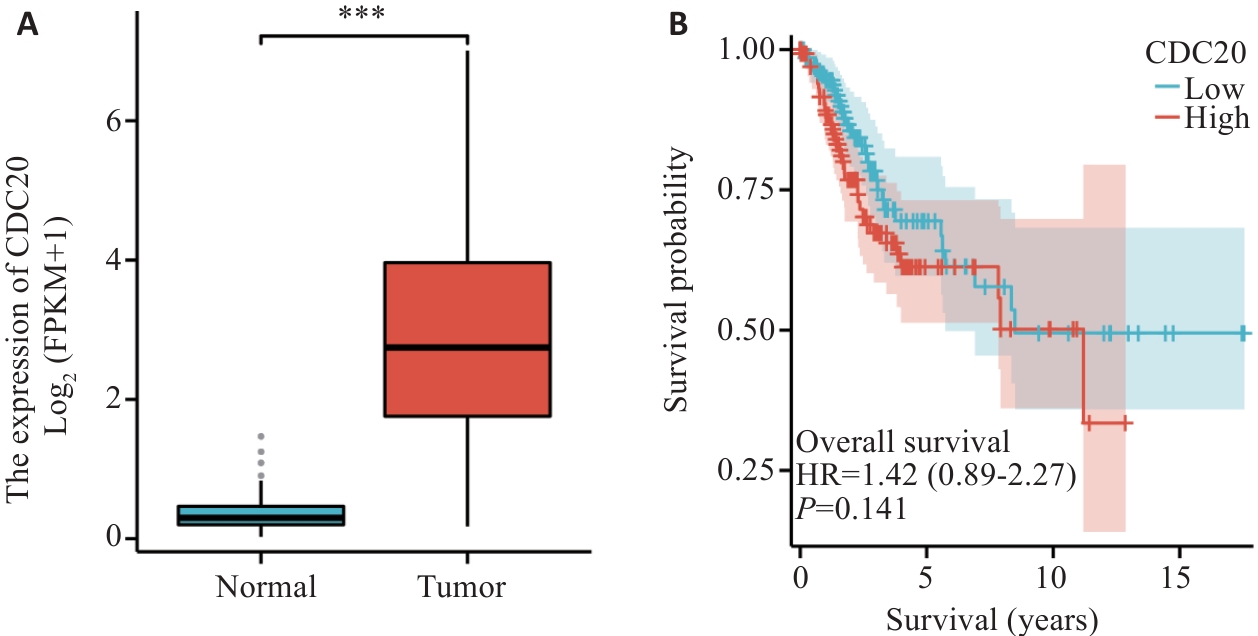
Fig.1 Analysis of CDC20 expression in cervical cancer vs normal tissues and its impact on patient survival. A: Analysis of CDC20 levels in cancer (red) vs normal (green) tissues based on TCGA data. B: CDC20 expression level is correlated with survival of cervical cancer patients (red: high expression; green: low expression). ***P<0.001.
| Patients' age (year) | Number | Percentage of the age distribution | Adenocarcinoma type | Squamous cell carcinoma type |
|---|---|---|---|---|
| 20-30 | 3 | 1.38% | 1 | 1 |
| 30-40 | 17 | 7.80% | 2 | 3 |
| 40-50 | 66 | 30.28% | 18 | 33 |
| 50-60 | 74 | 33.94% | 23 | 31 |
| 60-70 | 45 | 20.64% | 10 | 22 |
| 70-80 | 8 | 3.67% | 3 | 1 |
| 80+ | 4 | 1.83% | 2 | 2 |
| Total | 218 | 100% | 59 | 93 |
Tab.3 Age distribution of cervical cancer patients with different histopathological types
| Patients' age (year) | Number | Percentage of the age distribution | Adenocarcinoma type | Squamous cell carcinoma type |
|---|---|---|---|---|
| 20-30 | 3 | 1.38% | 1 | 1 |
| 30-40 | 17 | 7.80% | 2 | 3 |
| 40-50 | 66 | 30.28% | 18 | 33 |
| 50-60 | 74 | 33.94% | 23 | 31 |
| 60-70 | 45 | 20.64% | 10 | 22 |
| 70-80 | 8 | 3.67% | 3 | 1 |
| 80+ | 4 | 1.83% | 2 | 2 |
| Total | 218 | 100% | 59 | 93 |
| CDC20 expression | Pathological type | Degree of differentiation | Clinical staging | Lymph node metastasis | ||||
|---|---|---|---|---|---|---|---|---|
| Squamous cell carcinoma | Adenocarcinoma | Medium and low differentiation | High differentiation | I、II stage | III stage | No exist | Exist | |
| Positive | 93 (42.7%) | 59 (27.1%) | 159 (72.9%) | 188 (86.2%) | 46 (21.1%) | 191 (87.6%) | 12 (26.1%) | 24 (52.2%) |
| Negative | 125 (57.3%) | 159 (72.1%) | 59 (27.1%) | 30 (13.8%) | 172 (78.9%) | 27 (12.4%) | 9 (19.6%) | 1 (2.2%) |
| P | >0.05 | >0.05 | <0.05 | <0.05 | ||||
Tab.4 Analysis of CDC20 expression in patients with different clinicopathological characteristics (218 Cases)
| CDC20 expression | Pathological type | Degree of differentiation | Clinical staging | Lymph node metastasis | ||||
|---|---|---|---|---|---|---|---|---|
| Squamous cell carcinoma | Adenocarcinoma | Medium and low differentiation | High differentiation | I、II stage | III stage | No exist | Exist | |
| Positive | 93 (42.7%) | 59 (27.1%) | 159 (72.9%) | 188 (86.2%) | 46 (21.1%) | 191 (87.6%) | 12 (26.1%) | 24 (52.2%) |
| Negative | 125 (57.3%) | 159 (72.1%) | 59 (27.1%) | 30 (13.8%) | 172 (78.9%) | 27 (12.4%) | 9 (19.6%) | 1 (2.2%) |
| P | >0.05 | >0.05 | <0.05 | <0.05 | ||||

Fig.2 Immunohistochemical analysis of CDC20 and β-Catenin in cervical cancer and normal tissues (Original magnification: ×100). A, B: CDC20 expression in cervical cancer and adjacent tissues. C, D: β-Catenin expression in cervical cancer and adjacent tissues. E, F: Comparison of CDC20 and β-Catenin expression levels between cervical cancer and adjacent tissues (5 fields per section). Data are presented as Mean±SD (n=3). **P<0.01 vs Tumor.

Fig.3 Results of C33A-CRISPR-CDC20 sgRNA genome PCR and sequencing. A: Agarose gel of PCR products. B: Sequencing results of the C33A-CRISPR-CDC20 sgRNA cells and sgRNA-NC cells.
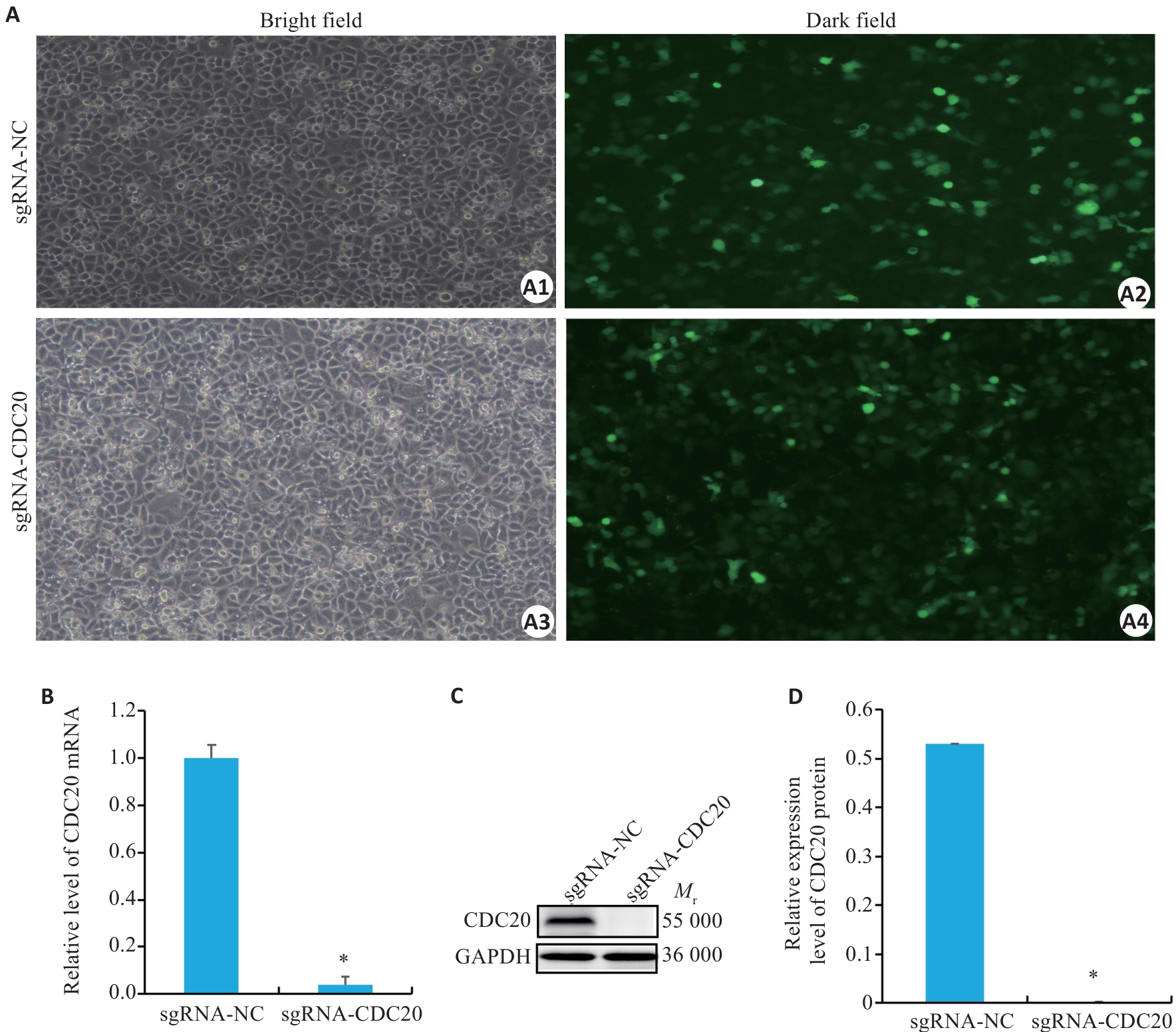
Fig.4 Validation of CDC20 gene knockdown (Mean±SD, n=3). A: Fluorescent transfection using sgRNA-CDC20 (×100). B: CDC20 knockout confirmed by qRT-PCR. C: sgRNA-CDC20 knockdown shown by Western blotting. D: Quantification of CDC20 expression levels. *P<0.05 vs sgRNA-NC group.
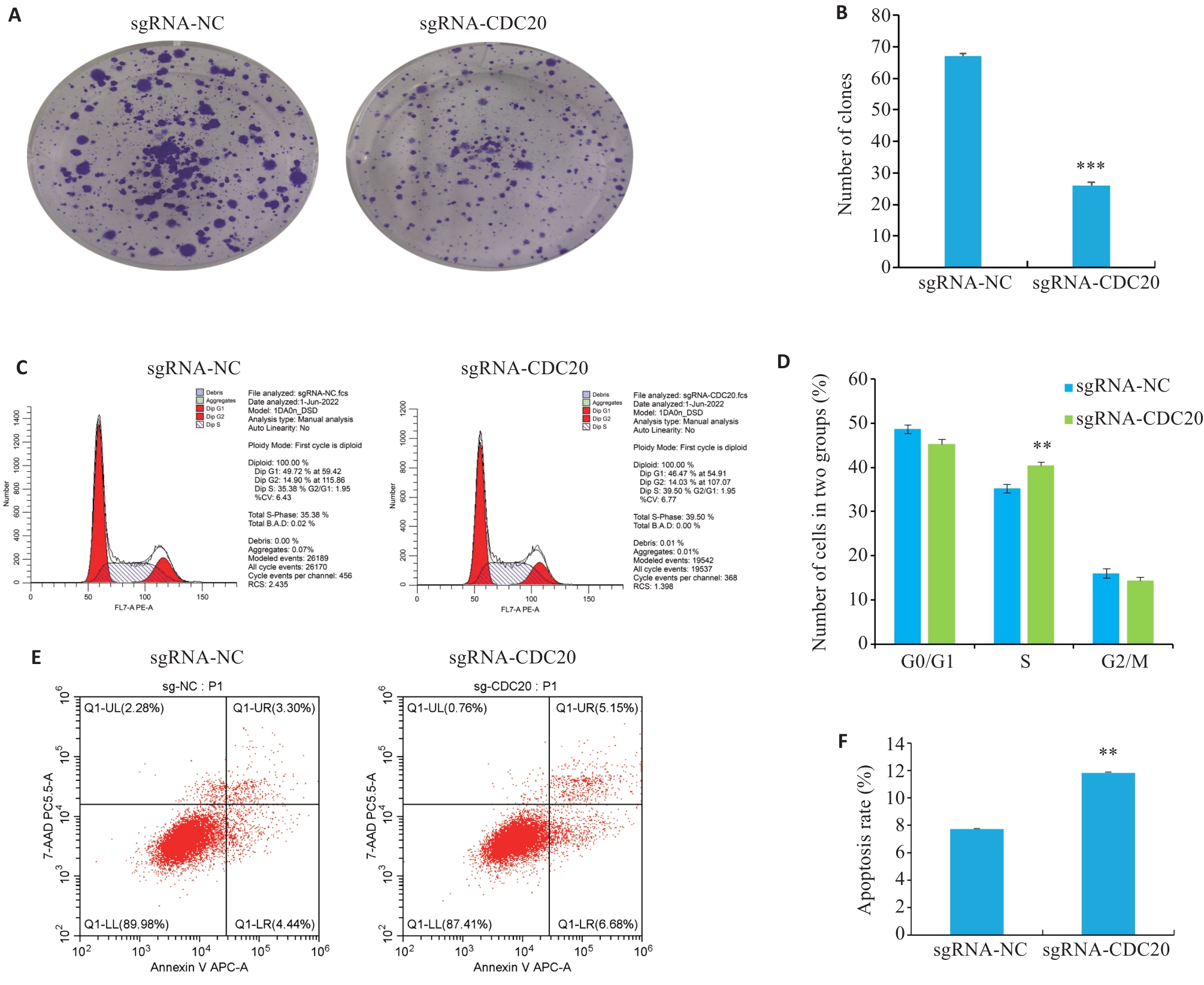
Fig.5 Impact of CDC20 knockdown on clone formation (A, B), cell cycle (C, D) and apoptosis (E, F) in cervical cancer C33A cells (Mean±SD, n=3). **P<0.01, ***P<0.001 vs sgRNA-NC group.

Fig.6 CDC20 knockdown inhibits migration and invasion of cervical cancer C33A cells (Mean±SD, n=3). A, B: Impact of CDC20 knockdown on migration and invasion of C33A cells (×100). C, D: Quantitative analysis of cell migration and invasion data. *P<0.05 vs sgRNA-NC group.
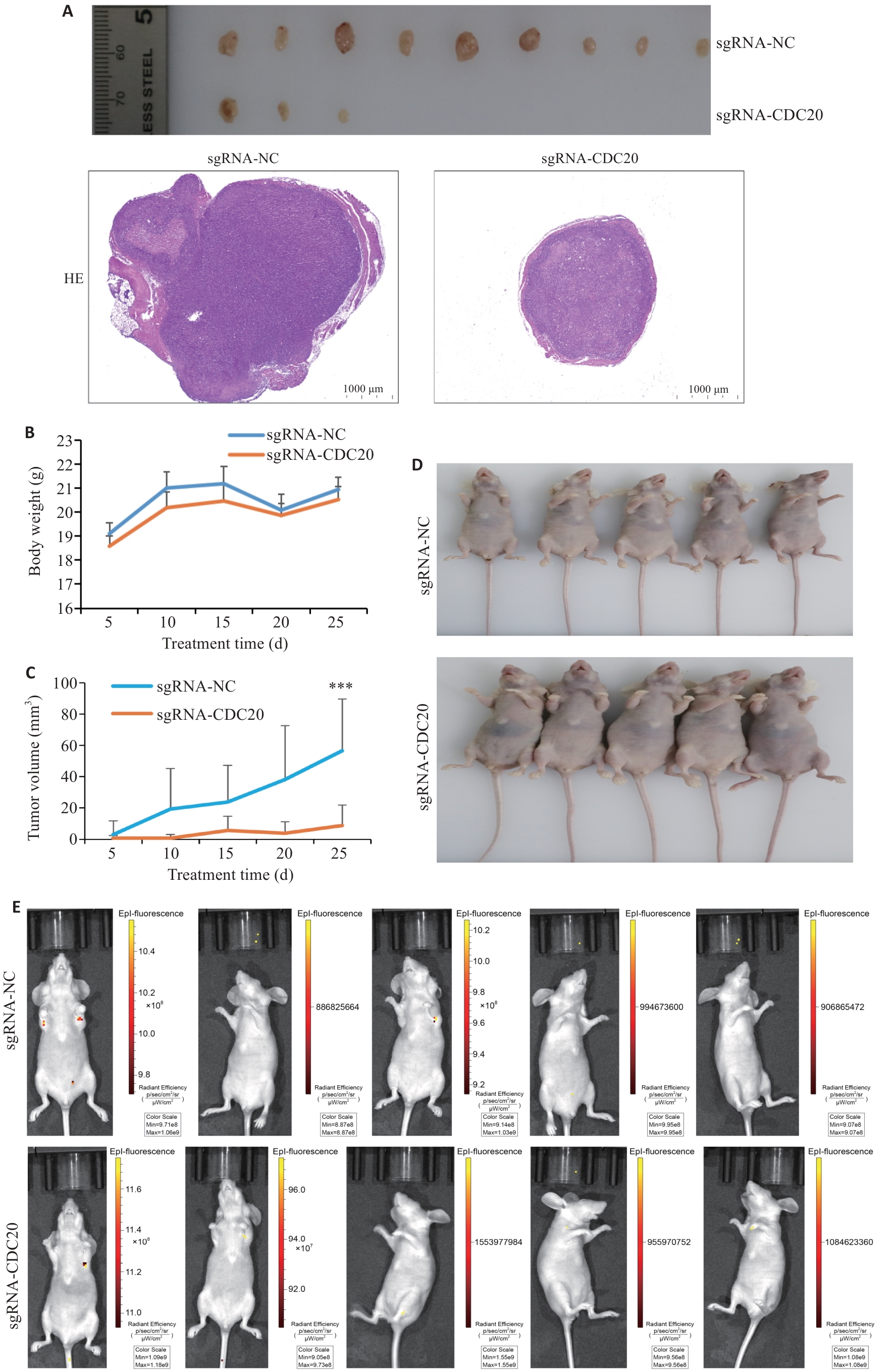
Fig.7 CDC20 knockdown suppresses xenograft tumor growth in nude mice (Mean±SD, n=3). A: Sizes and HE staining of the dissected tumors (×100). B: Body mass changes of the nude mice in the two groups. C: Tumor growth curves in the two groups. D: Observation of the tumor-bearing nude mice in the two groups. E: In vivo imaging of nude mice in the two groups. **P<0.001 vs sgRNA-NC group.
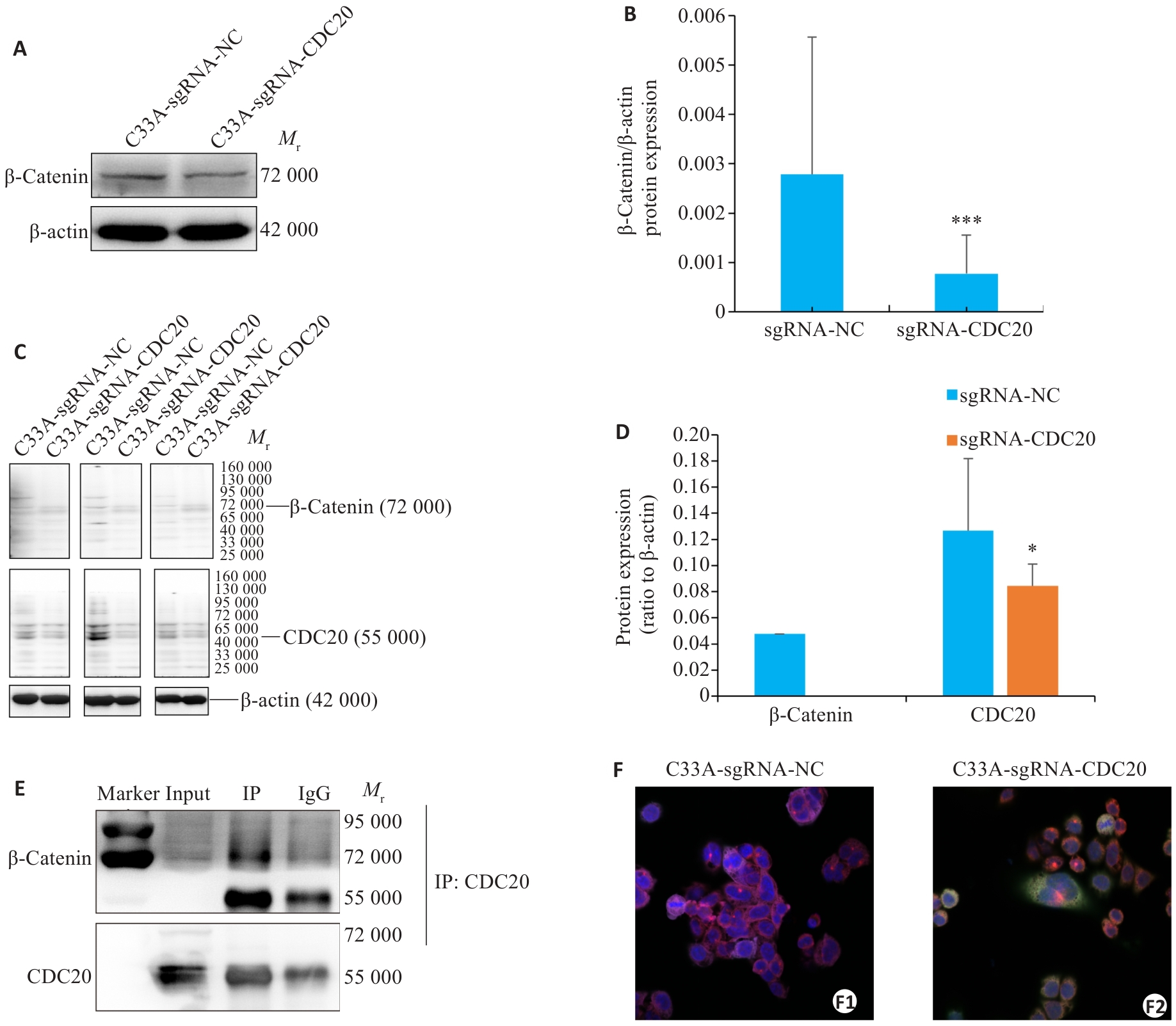
Fig.8 CDC20 knockdown suppresses cervical cancer cell migration and invasion via the β-Catenin pathway. A, B: Western blotting for detecting β-Catenin levels in C33A cells (Mean±SD, n=3; ***P<0.001 vs sgRNA-NC group). C, D: Western blotting for detecting CDC20 and β‑Catenin expressions in tumor tissues from nude mic (Mean±SD, n=5; *P<0.05 vs sgRNA-NC group). E: Co-IP confirms CDC20 and β-Catenin interaction in mouse tissues. F: Immunofluorescence co-localization assay showing CDC20 and β-Catenin co-expression in C33A cells (×100).
| 1 | Sung H, Ferlay J, Siegel RL, et al. Global cancer statistics 2020: GLOBOCAN estimates of incidence and mortality worldwide for 36 cancers in 185 countries[J]. CA Cancer J Clin, 2021, 71(3): 209-49. doi:10.3322/caac.21660 |
| 2 | Lin M, Ye MM, Zhou JH, et al. Recent advances on the molecular mechanism of cervical carcinogenesis based on systems biology technologies[J]. Comput Struct Biotechnol J, 2019, 17: 241-50. doi:10.1016/j.csbj.2019.02.001 |
| 3 | Bruni L, Serrano B, Roura E, et al. Cervical cancer screening programmes and age-specific coverage estimates for 202 countries and territories worldwide: a review and synthetic analysis[J]. Lancet Glob Health, 2022, 10(8): e1115-27. doi:10.1016/s2214-109x(22)00241-8 |
| 4 | Wang S, Chen B, Zhu Z, et al. CDC20 overexpression leads to poor prognosis in solid tumors: a system review and meta-analysis[J]. Medicine: Baltimore, 2018, 97(52): e13832. doi:10.1097/md.0000000000013832 |
| 5 | Gayyed MF, El-Maqsoud NMRA, Tawfiek ER, et al. A comprehensive analysis of CDC20 overexpression in common malignant tumors from multiple organs: its correlation with tumor grade and stage[J]. Tumor Biol, 2016, 37(1): 749-62. doi:10.1007/s13277-015-3808-1 |
| 6 | Song C, Lowe VJ, Lee S. Inhibition of Cdc20 suppresses the metastasis in triple negative breast cancer (TNBC)[J]. Breast Cancer, 2021, 28(5): 1073-86. doi:10.1007/s12282-021-01242-z |
| 7 | Xi X, Cao T, Qian Y, et al. CDC20 is a novel biomarker for improved clinical predictions in epithelial ovarian cancer[J]. Am J Cancer Res, 2022, 12(7): 3303-17. |
| 8 | Liu Y, Zou SH, Gao X. Bioinformatics analysis and experimental validation reveal that CDC20 overexpression promotes bladder cancer progression and potential underlying mechanisms[J]. Genes Genom, 2024, 46(4): 437-49. doi:10.1007/s13258-024-01505-x |
| 9 | Zhang Q, Huang H, Liu A, et al. Cell division cycle 20 (CDC20) drives prostate cancer progression via stabilization of β-catenin in cancer stem-like cells[J]. EBioMedicine, 2019, 42: 397-407. doi:10.1016/j.ebiom.2019.03.032 |
| 10 | Chu Z, Zhang X, Li Q, et al. CDC20 contributes to the development of human cutaneous squamous cell carcinoma through the Wnt/β-catenin signaling pathway[J]. Int J Oncol, 2019, 54(5): 1534-44. |
| 11 | Pang F, Shi D, Yuan L. Screening and identification of key genes for cervical cancer, Ovarian Cancer and endometrial cancer by combinational bioinformatic analysis[J]. Curr Bioinform, 2023, 18(8): 647-57. doi:10.2174/1574893618666230428095114 |
| 12 | Lin Y, Kong LL, Zhao YT, et al. The oncogenic role of EIF4A3/CDC20 axis in the endometrial cancer[J]. J Mol Med, 2024, 102(11): 1395-410. doi:10.1007/s00109-024-02486-w |
| 13 | Yu SJ, Zhao RR, Zhang BC, et al. Research progress and application of the CRISPR/Cas9 gene-editing technology based on hepato-cellular carcinoma[J]. Asian J Pharm Sci, 2023, 18(4): 100828. doi:10.1016/j.ajps.2023.100828 |
| 14 | Chunjing L, Yujie Y, Wei Z, et al. Effect of silencing CDC20 on proliferation and cell cycle of endometrial cancer cells by inhibiting Wnt/β‑catenin signaling pathway[J]. Journal of Jilin University (Medicine Edition), 2024, 50(5): 1305-12. |
| 15 | Wang BQ, Li XP, Liu L, et al. β‑Catenin: oncogenic role and therapeutic target in cervical cancer[J]. Biol Res, 2020, 53(1): 33. doi:10.1186/s40659-020-00301-7 |
| 16 | 许晓燕, 冯 群, 夏 嫱. Wnt/β-catenin信号通路在宫颈癌发生发展中的研究进展[J]. 医学信息, 2021, 34(5): 1-5. doi:10.3969/j.issn.1006-1959.2021.05.001 |
| 17 | 莫艳秀, 徐欧欧, 李梁政, 等.基于TCGA数据库探讨CDC20在宫颈癌组织中的表达及其对癌细胞自噬的影响[J].现代肿瘤医学, 2025,33(3): 375-87. doi:10.3969/j.issn.1672-4992.2025.03.004 |
| 18 | 莫艳秀, 陈淑娟, 范云鹏, 等. 顺铂作用于人恶性睾丸生殖细胞瘤NT2细胞后对肿瘤干细胞标志物的影响[J]. 生命科学研究, 2018, 22(5): 390-6. doi:10.16605/j.cnki.1007-7847.2018.05.008 |
| 19 | 莫艳秀, 姚飞虹, 刘峻彤, 等. SP600125对人宫颈癌HeLa细胞增殖和侵袭的影响[J]. 肿瘤防治研究, 2022, 49(4): 304-13. doi:10.3971/j.issn.1000-8578.2022.21.0807 |
| 20 | Mo YX, Fan YP, Fu W, et al. Acute immune stress improves cell resistance to chemical poison damage in SP600125-induced pol-yploidy of fish cells in vitro [J]. Fish Shellfish Immunol, 2019, 84: 656-63. doi:10.1016/j.fsi.2018.10.063 |
| 21 | Burmeister CA, Khan SF, Schäfer G, et al. Cervical cancer therapies: Current challenges and future perspectives[J]. Tumour Virus Res, 2022, 13: 200238. doi:10.1016/j.tvr.2022.200238 |
| 22 | Mondal G, Sengupta S, Panda CK, et al. Overexpression of Cdc20 leads to impairment of the spindle assembly checkpoint and aneuplo-idization in oral cancer[J]. Carcinogenesis, 2007, 28(1): 81-92. doi:10.1093/carcin/bgl100 |
| 23 | Ni K, Hong L. Current progress and perspectives of CDC20 in female reproductive cancers[J]. Curr Mol Med, 2023, 23(3): 193-9. doi:10.2174/1573405618666220321130102 |
| 24 | Tang J, Lu M, Cui Q, et al. Overexpression of ASPM CDC20 and TTK confer a poorer prognosis in breast cancer identified by gene co-expression network analysis[J]. Front Oncol, 2019, 9: 310. doi:10.3389/fonc.2019.00310 |
| 25 | 严龙君, 夏 萌, 李 明, 等. CDC20、TOP2A、NEK2的表达特征以及对食管鳞状细胞癌细胞增殖和迁移的影响[J]. 临床和实验医学杂志, 2022, 21(21): 2273-7. doi:10.3969/j.issn.1671-4695.2022.21.009 |
| 26 | 石 峰, 孙文功, 刘增振, 等. CDC20基因的表达对前列腺癌患者临床病理特征及预后的影响[J]. 解放军医学杂志, 2021, 46(11): 1092-7. |
| 27 | Gu Q, Li F, Ge S, et al. CDC20 knockdown and acidic microenvironment collaboratively promote tumorigenesis through inhibiting autophagy and apoptosis[J]. Molecular Therapy-Oncolytics, 2020, 17: 94-106. doi:10.1016/j.omto.2020.03.015 |
| 28 | Shang G, Ma X, Lv G. Cell division cycle 20 promotes cell proliferation and invasion and inhibits apoptosis in osteosarcoma cells[J]. Cell Cycle, 2018, 17(1): 43-52. doi:10.1080/15384101.2017.1387700 |
| 29 | Cheng S, Castillo V, Sliva D. CDC20 associated with cancer metastasis and novel mushroom-derived CDC20 inhibitors with antimetastatic activity[J]. Int J Oncol, 2019, 54(6): 2250-6. |
| 30 | Gao Y, Zhang B, Wang Y, et al. Cdc20 inhibitor apcin inhibits the growth and invasion of osteosarcoma cells[J]. Oncology reports, 2018, 40(2): 841-8. |
| 31 | Wang B, Wang M, Li X, et al. Variations in the Wnt/β-catenin pathway key genes as predictors of cervical cancer susceptibility[J]. Pharmgenomics Pers Med, 2020, 13: 157-65. doi:10.2147/pgpm.s248548 |
| 32 | Song P, Gao ZR, Bao YG, et al. Wnt/β-catenin signaling pathway in carcinogenesis and cancer therapy[J]. J Hematol Oncol, 2024, 17(1): 46. doi:10.1186/s13045-024-01563-4 |
| 33 | Deng Q, Wu L, Li Y, et al. MYBL2 in synergy with CDC20 promotes the proliferation and inhibits apoptosis of gastric cancer cells[J]. Advances in Clinical and Experimental Medicine, 2021, 30(9): 957-66. doi:10.17219/acem/135938 |
| 34 | Li K, Mao Y, Lu L, et al. Silencing of CDC20 suppresses metastatic castration-resistant prostate cancer growth and enhances chemo-sensitivity to docetaxel[J]. International Journal of Oncology, 2016, 49(4): 1679-85. doi:info:doi/10.3892/ijo.2016.3671 |
| Viewed | ||||||
|
Full text |
|
|||||
|
Abstract |
|
|||||